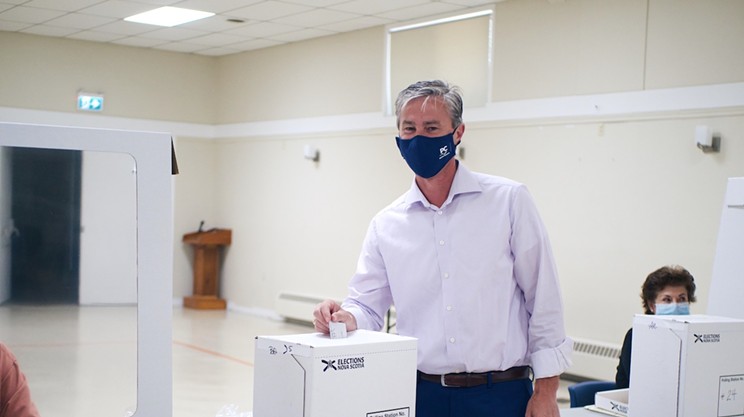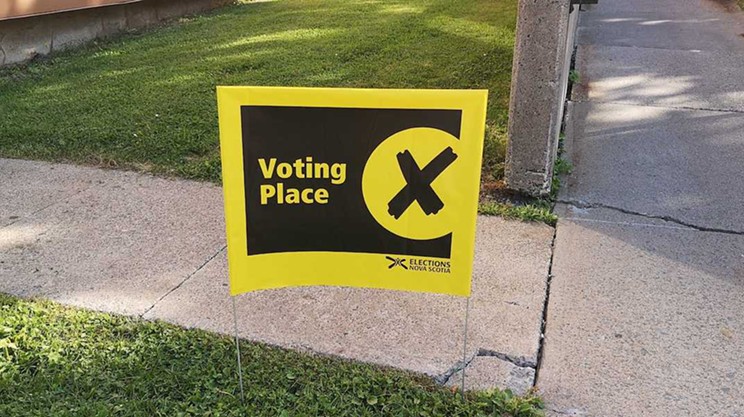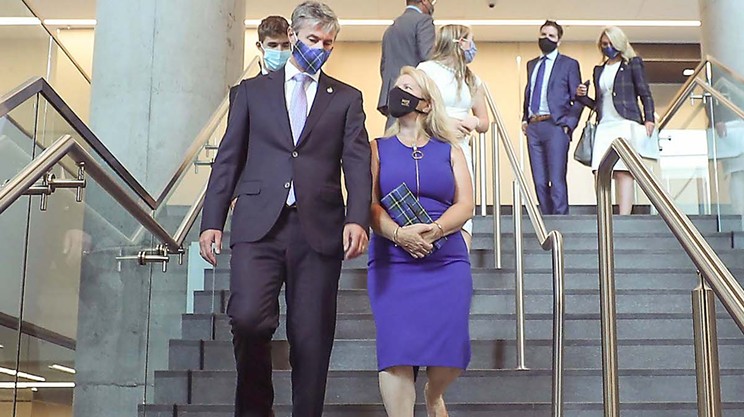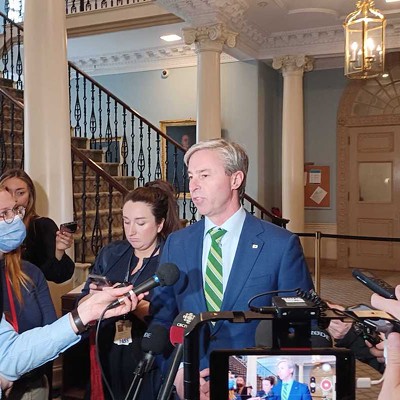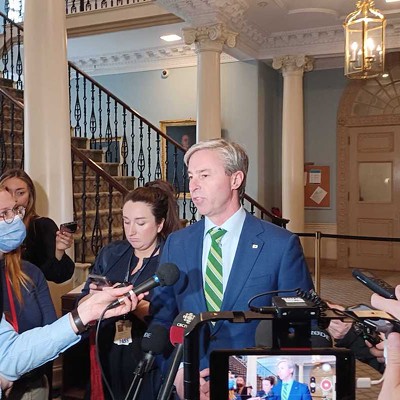Nova Scotia is the “home of responsible government in Canada,” the place that launched parliamentary democracy in Canada on October 2, 1758. This auspicious beginning lead to a minute 250 years later, back in the early aughts, when all these folks were singing our praises, and many Nova Scotians were walking around wearing D250 swag and events were happening across the province in tribute to our democratic pioneering tradition.
So, then, what the heck happened over the intervening years to bring us to a place where the average number of sitting days of the Nova Scotia legislature has decreased by seven days per year over the last decade, hovering somewhere in the high 30-something to mid-40-something days per year range?
Or to give rise to the evident malaise that the decreases in voter turnout in recent general elections surely illustrates?
Those are important, but not the only, markers of the health of our democracy. Depending on your perspective, the pandemic was either a very good or very bad time to take stock of our democratic vital signs. Some of those vital signs are beyond the control of the NS legislature—the health of the free press, for example. But many are not. And some are pretty straightforward to get done.
Despite—or maybe because of—general skepticism about our politics and government, maybe now’s the time to become democratic pioneers again.
The only real moment at which (in our current system of government) the members of the legislative assembly—Nova Scotia just elected the MLAs of the “64th General Assembly”—are conceivably “equal” in terms of their status and power is during the transition of government. These next few days before the August 31 swearing-in of the next provincial cabinet (technically called the “executive council”); that’s it, that’s all.
As soon as premier-designate Tim Houston exercises his most significant power—the power of appointment—to pick from among the MLAs elected under the Progressive Conservative Party banner and choose members of the executive council, a separation sets in between “insiders” and “outsiders.” The last cabinet before dissolution had 16 Liberal members, including premier Iain Rankin. In recent decades, Nova Scotia’s cabinet has generally hovered in the mid-teens in terms of membership, with NDP premier Darrell Dexter’s first cabinet containing 12 members, and PC Rodney MacDonald’s last cabinet containing 18 members.
Over the coming 1,460 days or so before the next general election, these roughly 14-18 rotating members of the executive council will gain access to information, staff, resources and the privilege—and responsibility—to exercise judgement, discretion and, yes, power over the lives of Nova Scotians in a massively asymmetrical way than the other 37-41 MLAs can or will.
By any standard, the asymmetry creates a huge devaluation and waste of time, money, brainpower and the human resources contained within our legislative assembly—because nearly two thirds of the elected members aren’t read into the details of the situation, or given enough information to make a meaningful contribution.
This is not a recipe for creating a de-facto 55-person extended membership of the cabinet/executive council, where they brook no opposition and suffer no one with a contrary opinion; far from it.
Political scientists JP Lewis and Paul Thomas chronicled the phenomenon of “Executive Creep in Provincial Legislatures” in their 2019 article in the Canadian Journal of Political Science. In brief, they argue that the increasing number of cabinet, cabinet-like and House leadership roles created in provincial legislatures have a way of “whipping” the government—and even senior opposition—members into a more and more controlled environment from the political centre. Bringing more people into the “tent,” in this way, has a knock-on effect of decreasing the breadth of opinion and diversity of perspectives, making more and more people fall in line.
To be sure, this is a problem, in Nova Scotia and elsewhere.
But rather than tackle the political party system, electoral system and broader legislative changes required to reform this, I’m advocating here for starting with the basics—education and information-sharing—that can (mostly) be done with the nod of the premier’s head and some marching orders from the clerk of the executive council. In the process we could maximize the effectiveness of all 55 newly-elected MLAs, and facilitate improved functioning of our political system and the quality of our democracy.Here are a few important numbers for context on the government of Nova Scotia—the trust these MLAs are elected to oversee:
- $15.5 billion—Nova Scotia’s 2021-22 budget
- 29-ish percent—the maximum likely number of newly-elected MLAs who will receive any kind of substantive briefing on the government they now run, as members of the cabinet
- $4,907,919.50—the combined base salary amount of the 55 new MLAs, before any additional stipends or honoraria for legislative, party leadership or executive council roles
- 25.4 percent—the percentage of Nova Scotians who are employed in the public sector (Canada-wide it is 21.4 percent)
With those stats in mind, about the enormity of the responsibility, what if we tried to do something different this time, during this 64th General Assembly? What if, for example, we decided to treat every elected legislator with greater equity (equality is an impossible standard here); like a valued and valuable part of our democratic system?
With a few simple changes Nova Scotia could benefit from:
- A less rancorous, and partisan, House of Assembly;
- A more productive use of taxpayers’ investment in the salaries, brains, experience of members of the Legislature; and,
- A more focused, effective opposition who are better equipped to produce improved public policy, and less on the daily grind of political whack-a-mole and headline-chasing.
I know those may sound a little like pipe dreams. My lived cynicism and experience in the political arena have been thankfully blunted a bit by being a part-time university politics prof over the last 18 months or so, and a father to kids who ask good, tough and sometimes unanswerable questions about why we do the things we do in the public sector, and occasionally playing translator when people ask “why do things work that way?”
Here are five *simple* ways I think we can make a big difference.
1 Level the information playing-field; re-imagine the on-boarding process
Brief all 55 MLAs, every single one. Explain the way that government departments and agencies, boards and commissions (ABCs) actually work, what their budgets are, their function(s), recent policy initiatives and intended system function. Highlight, in particular, the areas where inquiries, complaints and interaction with the public is highest, because these are the areas that will show-up as so-called “casework” in MLAs’ constituency offices, and are regularly the stuff of Question Period in the House of Assembly. Right now, only about 12-16 MLAs get any kind of formal “briefings” after elections—and those are the people named to the executive council. But would you believe that even those folks don’t even get briefed on how all of government works?
They may get some macro overviews, depending on what occasional groups or commissions their government have impanelled to focus on macro issues (e.g., the “One Nova Scotia” or Ivany Commission). But even a powerful cabinet minister only gets any kind of deep-dive briefing on the ministry(ies) for which they are responsible. That means that the remaining 39-ish MLAs are on an “as-is, where-is” basis in terms of their knowledge of how government has “worked.” They bring their biases and depth of background—or lack thereof—to the job of overseeing this enterprise. If you gave the 55 of them a basic exam on the functioning of the NS government…I guarantee a majority would fail. And it’s not their fault.
Who hires someone, and sends them only over to payroll/HR for the basic admin stuff, and doesn’t brief them on the fundamentals of their job? The investment we make in them is the return we’ll get. If we invest nothing up front, what we’ll get back is far less than the MLA-elects are capable of, or than we—as their employers—deserve. As it stands, the only common briefings all new MLAs get are from House of Assembly staff on things like financial administration of their offices; how the legislative library and legislative counsel (the people who write laws) works; and a subsequent briefing on the rules of the House. That’s it!
Why should it happen?
No one gets elected to the legislature knowing more than a little about the workings of our government; no one. We elect a lot of fabulous people, with great life experience, and the diversity of that legislature is beginning to get better with time. The reality is that the government does a lot of things. The more information they have, the better the ultimate decisions they will make; the correlation is clear. Know better = do better. And in the process, these 55 MLAs will get to know one another, across party lines, and form bonds, relationships, friendships that will open channels of communication and create a lot more room for “what ifs” to be manifested within our government.
Who can make it happen?
Premier, clerk of the executive council
When could it happen?
Literally, within a few weeks or so from now. Transition briefing books are all prepared to brief the new government, the incoming cabinet and their staff. Senior staff are ready to explain the inner workings of their departments to a new crop of ministers. Briefing 55 people instead of one is a question of scale, not do-ability.
Why mightn’t it happen?
Reverse inertia (read: “we’ve never done this before”); or “we’re giving the opposition bumpf for question period;” or “we don’t know where to draw the line on confidentiality;” or “we work for the government—which is only the ministry—so this is not our job;”, or “that’s what opposition and government caucus office staff are for,” et cetera.
2 Extend seats on key cabinet committees to not only the handful of government backbenchers, as has become custom over about the last 12 years in NS, but also to the opposition leaders and/or opposition house leaders, as a start.
Why should it happen?
Cabinet, and its committees, are the key points of power in the provincial government. Michael Wernick, former clerk of the privy council in Ottawa, estimated that the federal cabinet meets about 90 hours per year—making time the most valuable commodity in Ottawa’s decision-making hierarchy. In NS, the provincial cabinet probably meets more like 120-140 hours a year, making key decisions about the administration of over $15 billion in programs and expenditures. In New Brunswick, premier Higgs created a cabinet committee on COVID that included all the opposition leaders. It wasn’t perfect, but it created a space for dialogue, varied perspectives and “sober second thought” before cabinet made its final decisions. There’s a saying in government: “Garbage in = garbage out.” So why not equip the cabinet decision-making structure to become more robust and inclusive of different perspectives? It can only improve the ultimate output.
Who can make it happen?
Premier, cabinet, opposition leaders. Premier-designate Houston has already taken a modest step in this direction by inviting the two other party leaders to his first briefing with chief medical officer of health Robert Strang on Wednesday.
When could it happen?
Literally, with a decision of the executive council at its first meeting, when it establishes the new cabinet committee structure. It’s really the premier’s call: if he wanted it to happen, it would.
Why mightn’t it happen?
It would be a little clunky at first, of course. Like an awkward series of first dates, maybe. Everyone in information-gathering mode, with a dash of political grandstanding…until people realize it’s not televised, and the guard comes down a little. And, if—quite literally—all of the people on the government side are new to it…then it’s not really “different” to them, or weird…is it? There would likely also be some deep-over-thinking of various constitutional conventions, such as that concerning cabinet confidence; what needs to be kept secret outside the room, and what can be shared. In practice, though, it’s going to be a perfect test case for principles of Design Thinking—and we can innovate our way to respecting the lines that demarcate various roles of government and opposition, while also recognizing that everyone in the legislature’s job is to do their best for and on behalf of Nova Scotia, full stop.
3 Throw open the doors, and witness chairs, of the legislature and its committees.
Nova Scotia has made some limited changes to its standing committee structure over the last decade or so, some of which were seen as significant backward steps, such as the changes to the standing committee on public accounts in 2018 that limited its scope, changed the control of the committee from opposition-led to government-led and created a new standing committee on health. The reality is that the committee structure, and the resulting “work” of the legislators who serve on committees, is very niche, and inspired at least in some measure from either an “offensive” posture (illustrate weaknesses or poor decisions by the party in government), or a “defensive” posture (humble-bragging about the great things a particular government is accomplishing).
You can guess which parties bring which topics to the table when they hash out witness lists (those who are called before committees, the topics on which they are asked to speak, et cetera). If, instead, MLAs were to reverse the onus on coming up with topics and witnesses, and instead invite Nova Scotians and organizations who wished to appear to make submissions to them outlining why, on what topics, and “who” they think should appear, it would be a much closer approximation of Nova Scotians’ priorities than the current system.
Lastly, the use of special or select committees should be regularized, giving MLAs the ability to focus and hone in on one or two topics in-depth each year, including travelling and/or virtually visiting with experts and those impacted across the province with greater regularity. The fact that the use of select committees is so rare is not, in fact, a positive. These cross-party endeavours would help to bolster the quality and quantity of work done by our legislators.
Why should it happen?
As it stands, the government controls the committee structures; even moreso when they hold a majority of seats in the legislature. Much like some kind of computer game, MLAs and those in the caucus and premier’s offices do a “damage assessment” of potential topics before agreeing to who should be called, and what they should be asked to speak about.
Who can make it happen?
Premier, committee chairs
When could it happen?
Literally, at the first meeting of each newly-reconstituted committee next month
Why mightn’t it happen?
Control; they will not want to relinquish control. There will be a (no-doubt fierce) debate about how the committees would go about assessing the submissions made to them, how they would rank-order or adjudicate them for how deserving and/or pressing the topic is, how appropriate the witnesses are, et cetera. There will inevitably be complaints about the volume of witnesses who come forward, and the resulting work for the committee office staff, et cetera. These are red herrings.
4 Create more predictability, and build-in more flexibility, to the legislative calendar by creating a 12-month rolling legislative calendar with fixed timing for the legislature and committee meetings, and reforming the hours and structure of Legislature sittings.
As I mentioned earlier, Nova Scotia is on a downward trend in the number of days the legislature sits each year. Currently, the House of Commons in Ottawa sits somewhere between two to four times as many days per year as our legislative assembly does. The speaker is asked, at the behest of the premier, to give 30 days notice of a legislative sitting. They happen twice a year, one “Spring” sitting, and one “Fall” sitting. Sometimes, they last a matter of a couple of weeks.
Even when governments make conscious efforts to greatly extend the amount of time the legislature meets, they sometimes find themselves starved for “House business” because of the conventional, old-school and some might even say out-dated conception of what should qualify as being worth the time of our legislators. Some of the key features of these changes should be: An annual calendar laying out the sitting dates for the year, including the (minimum) length of sittings; setting standard sitting hours, and placing greater limits on the ability to sit “extended hours” except in the event of genuine emergency or urgent public business; extending the length of sittings but including “break weeks” as the federal parliament does; and providing more time for legislative standing committees.
Why should it happen?
The system we have suits the workforce of the past—older, predominantly white, men. Limited changes have been made to the functioning of the legislature in recent years, but most of those were COVID-inspired and do not address the structural inequities. It is hard to be a legislator when the House is in session; the fact that they do not sit for more than one-to-two months per year, in sum, should not undermine this reality. If you’re a “city” MLA, then the expectations on you to be participating in constituency events while the House is sitting—often long days and hours—do not necessarily abate, leading to a situation where urban MLAs are stretched thin on the work front, to say nothing of the unmet expectations and obligations in their family lives. For rural MLAs, being in the city all week removes them from the evening event obligations in their home constituencies, to some extent, but increases the pressure when they are home from Friday evening to Monday morning, leaving them sacrificing family time all week.
Who can make it happen?
Premier, house leaders, committee on assembly matters
When could it happen?
By the end of September
Why mightn’t it happen?
Control. Habit. Tradition. Precedent. If “cost” is used as an excuse, that’s BS. The incremental costs to longer sittings are minimal, because the sunk costs of investing in staff for the House of Assembly, legislative TV, et cetera, are already largely made, as are the costs for our MLAs’ compensation. Most MLAs already travel to the city weekly for the Wednesday caucus meetings, when the legislature is not sitting, and are reimbursed for those travel costs, so any associated costs there are negligible.
5 Bring communities into the legislature, literally and figuratively.
The legislature itself can’t move—it’s a grand old building on Hollis Street. The people within and elected to it can, and often do, move around the province in an effort to perform their additional roles as ministers, opposition critics or in other legislative roles. But the communities around the province don’t get a chance to come into the legislature very often, and if they do, it’s often for a one-dimensional reason in support of, or opposition to, a matter of public policy. The 54 other MLAs, with the possible exception of one’s neighbouring constituency MLAs, don’t generally get to know the communities within a given constituency very well during the life of any General Assembly. Maybe it’s time for the 64th General Assembly to change that. If, as part of the scheduled house business, each of the 55 constituencies got allocated a few hours to introduce their community to the legislature, how would that change the view(s) of various MLAs? How might that introduce them to the complexity, challenges and opportunities of each part of our province.
Why should it happen?
Knowledge is power. Quality data, and powerful anecdotes, illuminate and build understanding. The information and introduction each MLA gains to the diversity and uniqueness of each other constituency area—which are, to at least some extent, arbitrary divisions on a map—will strengthen the House of Assembly’s collective knowledge, compassion and understanding of the fabric of the province. As we meet and navigate existential challenges like climate change, this can only serve to improve the quality of debate and the context for decision making.
Who can make it happen?
House leaders, committee on assembly matters
When could it happen?
It could start this fall, and with something like a two-hour allocation to each constituency, would in and of itself increase the time spent by our legislators in the Main Chamber by about 35 percent.
Why mightn’t it happen?
Control. Habit. Tradition. Precedent. Questions about curation, how one might develop an agenda to reflect diverse constituencies within two hours. So, fine, increase the amount of time—but start somewhere. And make it an annual event, a “community check-in,” to both increase the diversity of voices and also add some longitudinal understanding of the changes in various regions.
At the end of the day, what we get out of the 64th General Assembly—this collection of 55 unique folks we’ve entrusted to govern our province for the next number of years—will to a large extent be informed by what we decide to entrust them with, how we empower them and how big a canvas we give them.
Small but significant changes like these represent new beginnings, and as the late, great Stuart MacLean once said: new beginnings are clumsy. But clumsy is not a valid reason not to do new things.
There are, without question, some fundamental reforms to our political and electoral systems that require serious debate, attention and action. But that shouldn’t stop us from making simple changes like those outlined here to improve the situation in the meantime.


